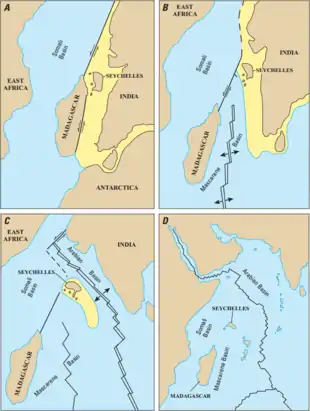Seychelles microcontinent
The Seychelles Microcontinent is a microcontinent underlying Seychelles in the western Indian Ocean made of Late Precambrian rock.
The granite outcrops of the Seychelles Islands in the central Indian Ocean were amongst the earliest examples cited by Alfred Wegener as evidence for his continental drift theory.[1] Ridge–plume interactions have been responsible for separating a thinned continental sliver from a large continent (i.e. India).[2]
The granites of the Seychelles Microcontinent were emplaced 750 Ma, during the late Precambrian.[3][4][5][6] Thermally-induced rifting in the Somali Basin and transform rifting along the Davie Fracture Zone began in the late Permian 225 million years ago, with Gondwana supercontinent beginning to break up in the Middle Jurassic (about 167 million years ago) when East Gondwana, comprising Antarctica, Madagascar, India, and Australia, began to separate from Africa; East Gondwana then began to separate about 115–120 million years ago when India began to move northward.[5]
The Seychelles Islands then underwent two more stages of rifting to isolate it from Madagascar and India. Between 84–95 million years ago rifting separated Seychelles/India from Madagascar. An initial period of transform rifting moved the Seychelles/India block northward.[5] At 84 million years ago oceanic crust started to form in the Mascarene Basin,[7] causing a rotation of the Seychelles/India land mass. This continued until 66 million years ago when new rifting severed the Seychelles from India forming the currently active Carlsberg Ridge. The rift jump coincided with the maximum output of the Deccan Traps,[8] and volcanics found on the Seychelles Plateau have also been linked with this event.[5] This has led to suggestions that the initiation of the Reunion plume caused rifting to jump to its current location.[9]
See also
- Geography of Seychelles
- Mascarene Plateau – Submarine plateau in the western Indian Ocean
- Mauritia (microcontinent) – A Precambrian microcontinent that broke away as India and Madagascar separated
References
Notes
Sources
- Duncan, R. A.; Pyle, D. G. (1988). "Rapid eruption of the Deccan flood basalts at the Cretaceous/Tertiary boundary" (PDF). Nature. 333 (6176): 841–843. doi:10.1038/333841a0. S2CID 4351454.CS1 maint: ref=harv (link)
- Gaina, C.; Müller, R. D.; Brown, B. J.; Ishihara, T. (2003). "Microcontinent formation around Australia". Evolution and Dynamics of the Australian Plate. Geological Society of America. doi:10.1130/0-8137-2372-8.405. ISBN 9780813723723.CS1 maint: ref=harv (link)
- Miller, J. A.; Mudie, J. D. (1961). "Potassium-argon age determinations on granite from the island of Mahé in the Seychelles Archipelago". Nature. 192 (4808): 1174–1175. doi:10.1038/1921174a0. S2CID 42032857.CS1 maint: ref=harv (link)
- Müller, R. D.; Gaina, C.; Roest, W. R.; Hansen, D. L. (2001). "A recipe for microcontinent formation". Geology. 29 (3): 203–206. doi:10.1130/0091-7613(2001)029<0203:ARFMF>2.0.CO;2.CS1 maint: ref=harv (link)
- Plummer, P. S.; Belle, E. R. (1995). "Mesozoic tectono-stratigraphic evolution of the Seychelles microcontinent". Sedimentary Geology. 96 (1): 73–91. doi:10.1016/0037-0738(94)00127-G.CS1 maint: ref=harv (link)
- Schlich, R. (1982). "The Indian Ocean: aseismic ridges, spreading centres and basins". The Ocean Basins and Margins. 6. New York: Plenum. pp. 51–147. doi:10.1007/978-1-4615-8038-6_2. ISBN 978-1-4615-8040-9.CS1 maint: ref=harv (link)
- Tucker, R. D.; Ashwal, L. D.; Torsvik, T. H. (2001). "U–Pb geochronology of Seychelles granitoids: a Neoproterozoic continental arc fragment". Earth and Planetary Science Letters. 187 (1): 27–38. doi:10.1016/S0012-821X(01)00282-5.CS1 maint: ref=harv (link)
- Wasserburg, G. J.; Craig, H.; Menard, H. W.; Engel, A. E. J.; Engel, C. J. (1963). "Age and composition of a Bounty Islands granite and age of a Seychelles Islands granite". J. Geol. 71 (6): 785–789. doi:10.1086/626954. JSTOR 30062225.CS1 maint: ref=harv (link)
- Wegener, A. (1924). The Origin of Continents and Oceans. New York: Methuen. ISBN 978-0-486-61708-4.CS1 maint: ref=harv (link)


